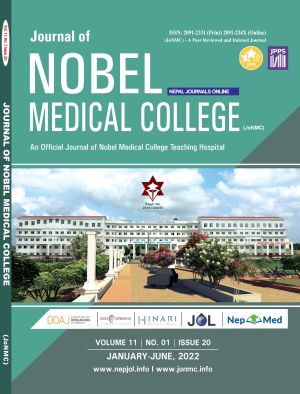Spleen Stiffness Measurement as Non-Invasive Surrogate for Esophageal Varices in Chronic Liver Disease
DOI:
https://doi.org/10.3126/jonmc.v11i1.45733Keywords:
Elastography, Esophageal varices, Fibrosis, Liver diseases, Portal hypertensionAbstract
Background: In patients with chronic liver diseases, liver and spleen stiffness measurement by elastography is the most recent available noninvasive tool. However, the accuracy for prediction of esophageal varices has been inconsistent across various studies. So, this study was done to evaluate the diagnostic performance of spleen stiffness measurement for detecting esophageal varices.
Materials and Methods: This descriptive cross-sectional study was done from 19 March to 30 June 2019. Participants who met inclusion and exclusion criteria were consecutively enrolled for the study and underwent upper gastrointestinal endoscopic examination along with measurement of liver and spleen stiffness by fibroscan.
Results: A total of 78 patients were enrolled. Mean age (±SD) was 49.79 (±10.92) years. Of 78 patients, 58 (74.4 %) had esophageal varices. Among patients with varices, Small esophageal varices were present in 44.8 % (26) and large esophageal varices were present in 55.2 % (32).Liver stiffness higher than 21.7 kPa was found to detect patients with large esophageal varices and the area under the receiver operating curve being 0.79 (95% confidence interval: 0.69 – 0.89); p<0.001. It had sensitivity of 100.0% and specificity of 63% in predicting the presence of large esophageal varices. While, spleen stiffness having a cutoff value of 40 kPa with the area under the receiver operating curve being 0.98 (95% confidence interval: 0.96 – 1.00); p<0.001, had sensitivity of 100.0 % and specificity of 87.0 % in predicting the presence of large esophageal varices.
Conclusion: Spleen stiffness measurements by Transient Elastography predict large esophageal varices better than liver stiffness measurements.
Downloads
Downloads
Published
How to Cite
Issue
Section
License

This work is licensed under a Creative Commons Attribution 4.0 International License.
JoNMC applies the Creative Commons Attribution (CC BY) license to works we publish. Under this license, authors retain ownership of the copyright for their content, but they allow anyone to download, reuse, reprint, modify, distribute and/or copy the content as long as the original authors and source are cited.




